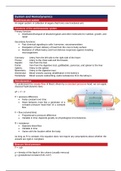System and Hemodynamics
Cardiovascular system
An organ system: A collection of organs that forms one functional unit.
Functions of the cardiovascular system
Primary function:
• Distribution/transport of dissolved gases and other molecules for nutrition, growth, and
repair
Secondary functions:
• Fast chemical signaling to cells: hormones, neurotransmitters
• Dissipation of heat: delivery of heat from the core to body surface
• Mediation of inflammatory and host defense responses against invading
microorganisms
Coronary: Artery from the left side to the right side of the heart
Thorax: Artery to the chest wall and the breasts
Hepatic: Vein from the liver
Portal: Vein from the digestive tract, gallbladder, pancreas, and spleen to the liver
Splenic: Artery to the spleen
Mesenteric: Artery to the digestive tract
Glomerular: Blood vessels causing ultrafiltration in the kidney’s
Peritubular: Blood vessels reabsorbing useful substances from the kidney’s
Hemodynamics
To understand the steady flow of blood, driven by a constant pressure head, we can apply
classical hydrodynamic laws.
∆𝑃 = 𝐹 ∗ 𝑅
P = pressure difference
• Fairly constant over time
• Heart behaves more like a generator of a
constant pressure head than of a constant
flow
F = flow (volume/time)
• Proportional to pressure difference
• Variable in time; depends greatly on physiological circumstances
R = resistance
• Opposes blood flow
• Variable in time
• Varies with the location within the body
As long as R is constant, this equation does not require any assumptions about whether the
vessels are rigid or compliant.
Measure blood pressure
P = ρgh
ρ = density of the liquid in the column (usually mercury)
g = gravitational constant (9.81 m/s2)
,h = height of column
P is usually expressed in millimeters of mercury (mm Hg) or centimeters of water (cm H2O).
Hydrostatic pressure
• Pressure exerted on the walls of the container
by the fluid within the container
• Proportional to the height of the water column
The flow depends on the pressure gradient (ΔP), not on
the absolute pressure (P).
ΔP in circulation
1. Driving pressure – axial
• Pressure difference between the arterial and venous ends of the circulation
• The only generator of blood flow when the vascular system is viewed as a long
horizontal tube.
2. Transmural pressure – radial
• Pressure difference between inside (lumen) and outside the vessel (interstitial)
• Governs vessel diameter → determines resistance R
3. Hydrostatic pressure – vertical
• Pressure difference between different height locations
• Exists even in the absence of blood flow
• ΔP = -ρg(h1 - h2)
The gravity causes hydrostatic pressure difference when there is a difference in height.
How is flow defined?
The flow of blood delivered by the heart, or the total mean flow in the circulation, is the cardiac
output (CO). The output during a single heartbeat, from either the left or right ventricle, is the
stroke volume (SV). For a given heart rate (HR):
CO = F = HR ∗ SV
The cardiac output is usually expressed in liters per minute.
Definition flow:
Flow is strongly related to the geometry of the vessel and the properties of the fluid.
ΔV
F= Δt
=A∗ v
Continuity of flow:
The narrower the vessel, the faster the velocity of flow.
-F1 = F2 → A1v1 = A2v2
Poiseuille’s law
Flow of fluid with viscosity η in a straight, rigid, cylindrical tube of inner radius r and length L.
πr4
F = ΔP
8ηL
Conditions:
• Constant driving pressure
• Rigid, cylindrical tube
, Viscosity
• Properties of the fluid, unrelated to any properties of the tube/vessel
• Expresses the degree of lack of
slipperiness in the fluid
o Viscosity decreases with
increasing the temperature
shear stress F/A
η= shear rate
= Δv/Δx
In a cylindrical blood vessel, the viscosity results
in a bullet-like velocity/flow profile. At the wall, the
velocity is the lowest, nearing 0. At the tip of the
bullet, the velocity is the highest.
Implications of Poiseuille’s law
By changing the radius of the tube slightly, the flow will increase by a power of 4.
Multiple resistances
In series, resistances sum up: Rt = R1 + R2 + R3
In parallel, the reciprocals of the resistances sum up: 1/Rt = 1/R1 + 1/R2 + 1/R3
Circulation
Pulmonary circulation: Caries deoxygenated blood away from the right ventricle, to the lungs.
Systemic circuit: Caries oxygenated blood to the organs.
Assumptions behind Poiseuille’s law
1. The fluid must be incompressible
Applies because blood is incompressible.
2. The tube must be straight, rigid, cylindrical, and unbranched, and have a constant
radius
Applies if you only look at a small piece of a vessel.
3. The velocity of the thin fluid layer at the wall must be zero (i.e., no “slippage”)
Applies, because the fluid takes the form of a bullet and because of endothelial cells the fluid
can never slip.
4. The flow must be laminar
Applies always for healthy vessels.
When there is laminar flow, there is no mixing between fluid layers. The critical parameter
between laminar and turbulent flow is called the Reynolds number (Re).
2rvρ
Re =
η






